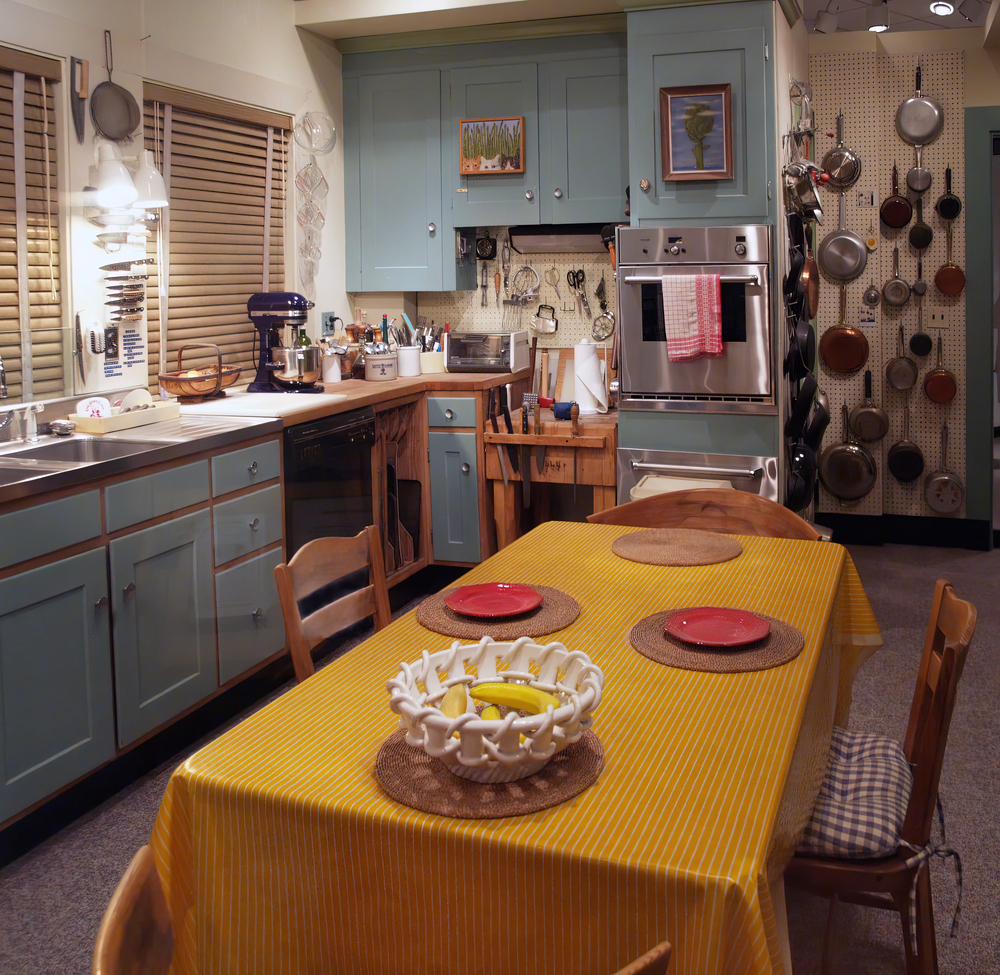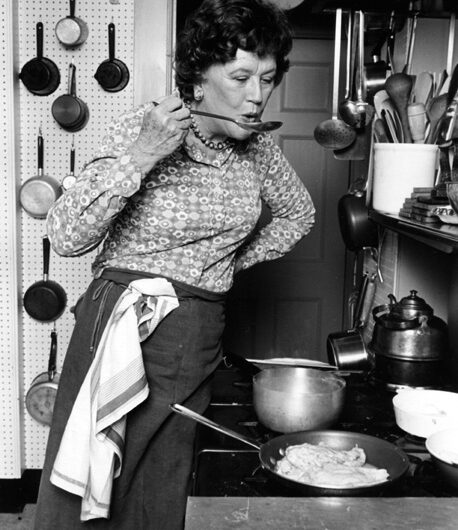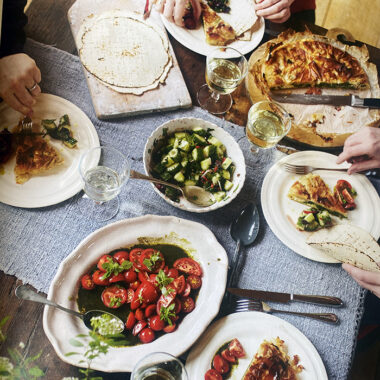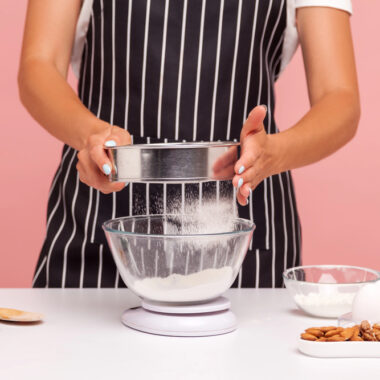Today we’re going to be continuing our series on what we can learn from famous chefs, present or past. This time, we’re going to be talking about Julia Child. She was a famous chef, a cookbook author, and a television personality. I’m sure you’ve seen those funny old video clips of her on the little TV screen with the round center from the sixties. She was one of the first women to host her own cooking show on television.
She gave people lots of tips, and she did lessons on how to prepare French food very simply and easily. Have you seen the movie Julie and Julia? It’s about a young girl learning to cook from Julia’s recipe. Julia Child left a legacy of more than just recipes. She’s taught people how to approach cooking and eating with a huge amount of joy, confidence, and curiosity. She loved food, she loved to eat, and she was so enthusiastic about it. She was very good at teaching you how to make things simple, and how to just go for it with your cooking.
The first thing we can learn from her about cooking that I want to mention is don’t be afraid to make mistakes. She said that the only real stumbling block is fear of failure. She believed that when you’re cooking, you’ve got to just go for it, and not worry about what could happen. Just enjoy it. Have fun. Don’t let it intimidate you if you drop a chicken, flip a pancake badly, or mess up a sauce. Just laugh, fix it, and keep going. It’s part of the process.
I love that because it reminds us that mistakes are not failures. They’re part of learning. That’s the right attitude to have with cooking. If we’re too afraid to try things, we’re never going to grow past our struggles. We’re never going to learn more. Cooking is meant to be fun because you get to eat it after you’re done, and it doesn’t have to be intimidating.
In one episode of hers, Julia Child flipped a potato pancake over, and it fell apart. She was calm – she scooped it up, smiled and said, you can just cover it up and serve it anyway. Mistakes don’t make you a bad cook; they make you a real cook. Every time you burn toast, or you’re making a sauce and it breaks, it teaches you something, and you’ll be better the next time. So, don’t be afraid of your mistakes. They’re going to be there.
Number two of the things we can learn from Julia Child is learn the basics, and then build from there. She really believed in mastering the fundamentals like knife skills – how to chop effectively, and the sauces, especially the five French mother sauces that you can then make derivatives from. I’m starting to learn those, but I haven’t mastered many of them. There are also techniques like roasting, sauteing, and baking.
Learning the basics and building from there means that you can cook just about anything. If you can learn how to chop onions, make beef stock, or saute vegetables, then you have the tools to cook anything. In her Mastering the Art of French Cooking cookbook, Julia Child starts with basic sauces, and then builds up slowly to complex dishes like boeuf bourguignon.
Remember to focus on core techniques. Watch a YouTube video, or learn something simple and practice it. Once you’ve done it a few times, it’ll be easier, and then you’ll be free to try the next level. You can also learn to cook confidently without always needing a recipe if you master the basic techniques.
Number three – use good ingredients. Use butter. Julie Child loved her butter – she said that with enough butter, anything is good. She always used fresh, quality ingredients – produce, herbs, and real butter. She didn’t believe in any of the dieting trends. She taught us about balance, meals that satisfy, and the pleasures of real food.
These flavorful ingredients made her food amazing, and especially her fondness for butter contributed, whether the food was vegetables, steak, or other meat. She taught that the quality ingredients make all the difference to the flavor of your meals. Instead of using low fat ingredients or shortcuts, she used real cream, fresh herbs, and ripe tomatoes – real, honest flavor. Use the best ingredients you can reasonably afford, and don’t be afraid to use things like butter.
Number four – be curious and adventurous when you’re cooking. Don’t cook on autopilot, or just follow a recipe, but smell the garlic sizzling, or feel the dough in your hands. Take pleasure in the way the beautiful colors of the salad or the vegetables look. Taste your sauce as it simmers – be present when you’re cooking.
Julia Child embraced all kinds of techniques – trying foreign foods and diving into French cuisine, but that was later on because her curiosity drew her to those things, and it was infectious. She had a love of learning, and she urged others to be curious in the kitchen and to try new things.
We don’t have to be that complicated with our cooking, but we should try to enjoy the process and to be present. It might be out of our comfort zone to be adventurous with our cooking, but it’ll have wonderful results. So, don’t just stick to what you know. Try something new; try different cultures’ food. Try something that you used to have as a child that you’ve never cooked before. Try something different and enjoy doing it.
Number five – cooking is for everyone. Julia Child really believed that people could be good cooks. She said that all of us should be trying to cook, and enjoying the process. She rejected the idea that gourmet cooking was for the elite, and she made French cuisine, which is supposed to be very difficult, approachable for home cooks. On her TV show, The French Chef, she would share many practical tips and show herself making a recipe with clear explanations and humor, demystifying the intimidating recipes. With just patience and practice, anyone can cook beautiful food.

Julia’s Kitchen
Number six – for her, food was about connection. Meals were meant to be shared with others; with family, friends, and guests. There was lots of laughter and lots of fun in the meals together. There was always a big wooden table in their house in the vineyards. They’d have lots of chairs around it, and guests would be coming for the meal and enjoying the time together. This applies to families as well. We can enjoy our time together as a family, make it about community and fellowship, and about enjoying conversation. We can make the food a way to facilitate that, a way to enjoy the time together.
Number seven – Julia Child really believed that cooking is a skill, not a talent. She didn’t believe that great cooks were born, but that they were made. She trained hard at Le Cordon Bleu cooking school, and she encouraged others to practice, and not worry about their mistakes. She said that if they mess up, they should just move on, improve, grow, and learn.
She said that you don’t need to be gifted to become a great cook. She didn’t believe in natural cooks. She believed in practice, repetition, learning from your failure, trying again, trying new things, just doing it, enjoying it, and having great results. She said that you’re not born a great cook. You become one with patience, mistakes, and a bit of bravery and perseverance.
Number eight – clean as you go, but don’t obsess. Julia encouraged cooks to stay organized and to keep a reasonably tidy workspace, but not to worry about making a little mess. Cooking can be messy, and should be joyful. She said “Don’t let perfection take the fun out of it, and don’t let a mess get in the way of joy or spontaneity in the kitchen.”
On her shows, her kitchen would often be cluttered. There would be ingredients and tools that she was using all over, but she kept things under control, and she always kept a working rhythm. She would wash a bit and tidy a bit as she cooked, but in balance. She wasn’t being so focused on cleanliness that she forgot to enjoy herself. I think that’s a good thing to learn to have that balance.
Number nine – have the right tools to use in the kitchen, but keep it simple and don’t overdo it. Julia believed in using quality tools like a really good knife, sturdy pans, and a whisk, but again she didn’t have too many gadgets. Her learning and improving technique, and she focused on quality of tools over quantity.
There were some that she just couldn’t do without, like a good chef’s knife, a heavy bottom pan, a whisk, and a wooden spoon. She kept them all organized on a pegboard in her kitchen with outlines, so everything had its place. Invest in tools that last, that feel good, and that are really useful, rather than having too many tools that you might or might not use, or that you think might make the job easier when it’s actually better to just do it by hand. Just have a few well chosen essentials.
Number ten – all the chefs recommend this; taste as you go. Julia Child constantly reminds us to taste while cooking, not just at the end. That’s how you build flavor – you adjust your seasoning as you go. You have to understand what each ingredient is going to bring to the dish. Taste while you cook. That’s how you learn what works and what tastes good.
When making a sauce, she would taste it at every stage. She would talk about what was missing – salt, a squeeze of lemon, or a touch of cream. Trust your palate, but also train it. Cooking is active, so taste your food, adjust it, and enjoy engaging with it.
Number eleven – be bold with flavor. Julia wasn’t shy with seasoning.
She embraced using garlic, wine, cream, mustard, herbs, spices, and strong cheeses. Her food was full of flavor and character. She taught us not to be timid when you’re building flavor; her food was never bland. She enjoyed the strong, aromatic rich flavor of garlic, onions, dijon mustard, red wine, heavy cream, herbs, anchovies, lots of butter, and et cetera.
She really believed that food should make a statement. In her coque al vin recipe, she layers flavors as she cooks – browning the meat, de-glazing the pan with wine, and then making it aromatic by simmering it. It’s got such depth and richness to it. So, don’t be afraid to experiment with bold seasonings. Try something new and unfamiliar in your dish – a pinch of cayenne pepper, a squeeze of lemon, or a splash of apple cider vinegar – anything that transforms your dish. Don’t be afraid to try new flavors, especially a little at a time.
Here’s a bonus tip – cook for people, not perfection. Julia believed that the real purpose of cooking was to connect with others, and feed them delicious food. Even if a dish wasn’t perfect, and wasn’t exactly how she’d hoped, the effort and care behind it mattered more than flawless execution and perfect flavor. Also, arranging it beautifully on the plate helps. Just that touch shows that someone’s love has gone into making it. Julia said “Let go of the pressure to impress. Focus on making food that’s comforting, thoughtful, and satisfying to those you’re feeding, even if it’s just yourself.”
She was a delightful chef. You should look up some videos of her on YouTube. Another thing she did so much is laugh in the kitchen from the bloopers on TV of her dramatic reactions to kitchen mishaps. She had so much character, she was so full of fun, and she had such a sense of humor. You should really go and watch something about her.
Don’t take yourself too seriously when you’re cooking. It should be joyful – it should challenge you, but be lots of fun. So, thank you, Julia, for those tips!





